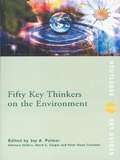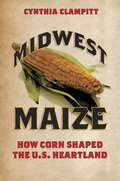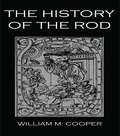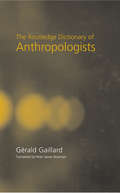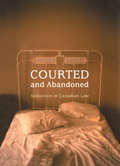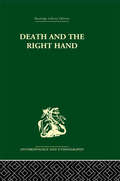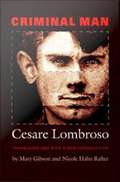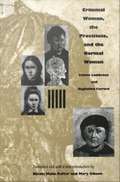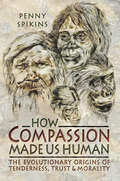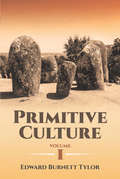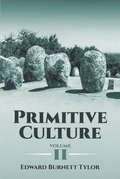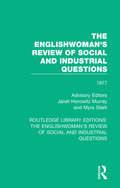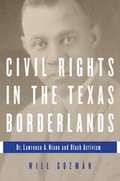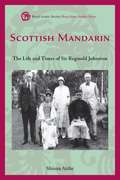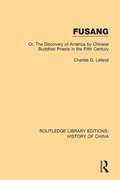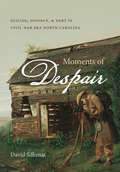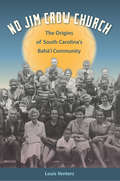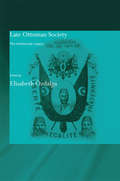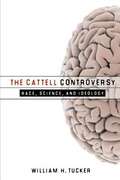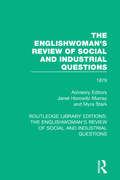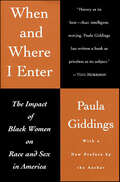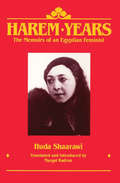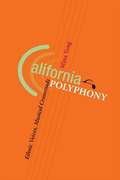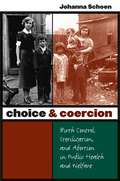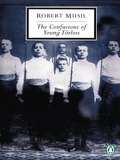- Table View
- List View
Fifty Key Thinkers on the Environment (Routledge Key Guides)
by Joy A. PalmerFifty Key Thinkers on the Environment is a unique guide to environmental thinking through the ages. Joy A. Palmer, herself an important and prolific author on environmental matters, has assembled a team of thirty-five expert contributors to summarize and analyse the thinking of fifty diverse and stimulating figures – from all over the world and from ancient times to the present day. Among those included are: Philosophers such as Rousseau, Spinoza and Heidegger Activists such as Chico Mendes Literary giants such as Virgil, Goethe and Wordsworth Major religious and spiritual figures such as the Buddha and St Francis of Assisi. Lucid, scholarly and informative, these fifty essays offer a fascinating overview of mankind’s view and understanding of the physical world.
Midwest Maize: How Corn Shaped the U.S. Heartland
by Cynthia ClampittFood historian Cynthia Clampitt pens the epic story of what happened when Mesoamerican farmers bred a nondescript grass into a staff of life so prolific, so protean, that it represents nothing less than one of humankind's greatest achievements. Blending history with expert reportage, she traces the disparate threads that have woven corn into the fabric of our diet, politics, economy, science, and cuisine. At the same time she explores its future as a source of energy and the foundation of seemingly limitless green technologies. The result is a bourbon-to-biofuels portrait of the astonishing plant that sustains the world.
History Of The Rod: A History Of The Rod In All Countries From The Earliest Period To The Present Time
by CooperFirst published in 2005. Routledge is an imprint of Taylor & Francis, an informa company.
The Routledge Dictionary of Anthropologists
by Gerald GaillardThis detailed and comprehensive guide provides biographical information on the most influential and significant figures in world anthropology, from the birth of the discipline in the nineteenth century to the present day. Each of the fifteen chapters focuses on a national tradition or school of thought, outlining its central features and placing the anthropologists within their intellectual contexts. Fully indexed and cross-referenced, The Routledge Dictionary of Anthropologists will prove indispensable for students of anthropology.
Courted and Abandoned
by Patrick BrodeA pregnancy outside of marriage was a traumatic event in frontier Canada, one that had profound legal implications, not only for the mother, but also for the woman's family, the alleged father, and for the entire community. Patrick Brode examines the history of the 'heartbalm' torts in nineteenth-century Canada - breaches of duty leading to liability for damages for seduction, breach of promise of marriage, and criminal conversation - that were part of the inherited English law and were a major feature of early Canadian law.Encompassing all ten Canadian provinces, Brode's study examines the court cases and the communities in which they arose. He illustrates the progression of these 'heartbalm' actions as women gained more and more autonomy in the late nineteenth century, until questions arose as to the applicability of these feudal remedies in a modern society. He argues that the heartbalm cases are a testament to how early Canadians tried to control sexuality and courtship, even consensual activity among adults. In mixing legal and social issues, and showing how they interact, Courted and Abandoned makes a significant contribution to legal history, women's studies, and cultural history.
Death and the right hand
by Robert HertzFirst published in English 1960. The historical value of Hertz's writings is that they are a representative example of the culmination of two centuries of development of sociological thought in France, from Montesquieu to Durkheim and his pupils. In the intervening years since publication, that development has grown into the systematic comparative study of primitive institutions, based on a great body of ethnographic facts from all over the world: in effect social anthropology.
Criminal Man
by Cesare LombrosoCesare Lombroso is widely considered the founder of criminology. His theory of the "born" criminal dominated European and American thinking about the causes of criminal behavior during the late nineteenth century and the early twentieth. This volume offers English-language readers the first critical, scholarly translation of Lombroso's Criminal Man, one of the most famous criminological treatises ever written. The text laid the groundwork for subsequent biological theories of crime, including contemporary genetic explanations. Originally published in 1876, Criminal Man went through five editions during Lombroso's lifetime. In each edition Lombroso expanded on his ideas about innate criminality and refined his method for categorizing criminal behavior. In this new translation, Mary Gibson and Nicole Hahn Rafter bring together for the first time excerpts from all five editions in order to represent the development of Lombroso's thought and his positivistic approach to understanding criminal behavior. In Criminal Man, Lombroso used modern Darwinian evolutionary theories to "prove" the inferiority of criminals to "honest" people, of women to men, and of blacks to whites, thereby reinforcing the prevailing politics of sexual and racial hierarchy. He was particularly interested in the physical attributes of criminals--the size of their skulls, the shape of their noses--but he also studied the criminals' various forms of self-expression, such as letters, graffiti, drawings, and tattoos. This volume includes more than forty of Lombroso's illustrations of the criminal body along with several photographs of his personal collection. Designed to be useful for scholars and to introduce students to Lombroso's thought, the volume also includes an extensive introduction, notes, appendices, a glossary, and an index.
Criminal Woman, the Prostitute, and the Normal Woman
by Cesare Lombroso Guglielmo FerreroCesare Lombroso is widely considered the founder of the field of criminology. His theory of the "born" criminal dominated discussions of criminology in Europe and the Americas from the 1880s into the early twentieth century. His book, La donna delinquente, originally published in Italian in 1893, was the first and most influential book ever written on women and crime. This comprehensive new translation gives readers a full view of his landmark work. Lombroso's research took him to police stations, prisons, and madhouses where he studied the tattoos, cranial capacities, and sexual behavior of criminals and prostitutes to establish a female criminal type. Criminal Woman, the Prostitute, and the Normal Woman anticipated today's theories of genetic criminal behavior. Lombroso used Darwinian evolutionary science to argue that criminal women are far more cunning and dangerous than criminal men. Designed to make his original text accessible to students and scholars alike, this volume includes extensive notes, appendices, a glossary, and more than thirty of Lombroso's own illustrations. Nicole Hahn Rafter and Mary Gibson's introduction, locating his theory in social context, offers a significant new interpretation of Lombroso's place in criminology.
How Compassion Made Us Human: The Evolutionary Origins of Tenderness, Trust & Morality
by Penelope SpikinsAn intriguing look at how our capacity to care about and connect with others has contributed to our evolutionary success as a species. Our ability to care about the wellbeing of others, whether they are close family or strangers, can appear to be unimportant in today&’s competitive societies. But in this volume, archaeologist Penny Spikins argues that compassion lies at the heart of what makes us human. She takes us on a journey from the earliest Stone Age societies two million years ago to the lives of Neanderthals in Ice Age Europe, using archaeological evidence to illustrate the central role that emotional connections had in human evolution. Simple acts of kindness left to us from millions of years ago provide evidence for how social emotions and morality evolved, and how our capacity to reach out beyond ourselves into the lives of others allowed us to work together for a common good—and form the basis for human success.
Primitive Culture Volume I
by Edward Burnett TylorUse of the term "culture" as an expression of the full range of learned human behavior patterns began with this classic two-volume work, first published in 1871. Edward B. Tylor, the first Professor of Anthropology at the University of Oxford, declared that culture is "that complex whole which includes knowledge, belief, art, law, morals, custom, and any other capabilities and habits acquired by man as a member of society." Tylor is credited with the establishment of anthropology as a scientific discipline, and his groundbreaking work was highly influential in the development of cultural evolution as the foundation for anthropologic studies. Tylor's unilinear model of development maintains that humans share a common history, evolving from a single primitive form. His studies of the languages, rituals, and beliefs of societies from around the world pioneered the use of statistical data and substantiated his view of a universal pattern of development in all cultures. Volume I of Primitive Culture focuses on social evolution, language, and myth. Volume II focuses on Tylor's interpretation of animism in society, offering details of the endlessly varied ideas and beliefs regarding the soul, spirits, and gods.
Primitive Culture, Volume II: Researches Into The Development Of Mythology, Philosophy, Religion, Art, And Custom, Volume 2 - Primary Source Edition (Cambridge Library Collection - Anthropology)
by Edward Burnett TylorThe first Professor of Anthropology at the University of Oxford, Edward B. Tylor, defined the term "culture" for modern readers in this groundbreaking work. Initially published in 1871, this classic two-volume study explores the full range of learned human behavior patterns in terms of the beliefs, wisdom, laws, artistic achievements, and mores that constitute a society. The formation of anthropology as a scientific discipline began with this work, which continues to exercise a profound influence on anthropologic studies. The shared history of all humans, a common ground that evolved from primitive roots, constitutes the basis for Tylor's model of development. Drawing upon a worldwide variety of beliefs, rituals, and languages, the author illustrates an all-inclusive pattern of progress. His methods inaugurated the use of statistical data in anthropology, a standard procedure today but a landmark for his time. Volume I of Primitive Culture examines social evolution, language, and myth. The focus of this second volume is animism in society, which explores the tremendous diversity of thinking related to the concepts of the soul and religion as well as the marked similarities of spiritual beliefs.
The Englishwoman's Review of Social and Industrial Questions: 1877 (Routledge Library Editions: The Englishwoman's Review of Social and Industrial Questions #10)
by Janet Horowitz Murray and Myra StarkThe Englishwoman’s Review, which published from 1866 to 1910, participated in and recorded a great change in the range of possibilities open to women. The ideal of the magazine was the idea of the emerging emancipated middle-class woman: economic independence from men, choice of occupation, participation in the male enterprises of commerce and government, access to higher education, admittance to the male professions, particularly medicine, and, of course, the power of suffrage equal to that of men. First published in 1979, this tenth volume contains issues from 1877. With an informative introduction by Janet Horowitz Murray and Myra Stark, and an index compiled by Anna Clark, this set is an invaluable resource to those studying nineteenth and early twentieth-century feminism and the women’s movement in Britain.
Civil Rights in the Texas Borderlands: Dr. Lawrence A. Nixon and Black Activism
by Will GuzmanIn 1907, physician Lawrence A. Nixon fled the racial violence of central Texas to settle in the border town of El Paso. There he became a community and civil rights leader. His victories in two Supreme Court decisions paved the way for dismantling all-white political primaries across the South. Will Guzmán delves into Nixon's lifelong struggle against Jim Crow. Linking Nixon's activism to his independence from the white economy, support from the NAACP, and the man's own indefatigable courage, Guzmán also sheds light on Nixon's presence in symbolic and literal borderlands--as an educated professional in a time when few went to college, as an African American who made waves when most feared violent reprisal, and as someone living on the mythical American frontier as well as an international boundary. A powerful addition to the literature on African Americans in the Southwest, Civil Rights in the Texas Borderlands explores seldom-studied corners of the Black past and the civil rights movement.
Scottish Mandarin
by Shiona AirlieColonial administrator, writer, explorer, Buddhist, and friend to China's last emperor, Sir Reginald Johnston (1874-1938) was a distinguished sinologist with a tangled love and family life that he kept secret even from his closest friends. Born and educated in Edinburgh, he began his career in the colony of Hong Kong and eventually became Commissioner of the remote British leased territory of Weihai in northern China. He travelled widely and, during a break from colonial service, served as tutor and advisor to Puyi, the deposed emperor. As the only foreigner allowed to work in the Forbidden City, he wrote the classic account of the last days of the Qing Dynasty--Twilight in the Forbidden City'.
Fusang: Or, The discovery of America by Chinese Buddhist Priests in the Fifth Century (Routledge Library Editions: History of China #7)
by Charles G. LelandThis book, first published in 1875 and reissued in 1973, analyses the limited evidence from the works of early Chinese historians that explorers from China had discovered a country they called Fusang – possibly western America, and in all probability Mexico. The original document on which Chinese historians based their accounts of Fusang was the report of a Buddhist monk called Hoei-shin, who, in the year 499 AD, returned from a long journey to the east.
Moments of Despair: Suicide, Divorce, and Debt in Civil War Era North Carolina
by David SilkenatDuring the Civil War era, black and white North Carolinians were forced to fundamentally reinterpret the morality of suicide, divorce, and debt as these experiences became pressing issues throughout the region and nation. In Moments of Despair, David Silkenat explores these shifting sentiments. Antebellum white North Carolinians stigmatized suicide, divorce, and debt, but the Civil War undermined these entrenched attitudes, forcing a reinterpretation of these issues in a new social, cultural, and economic context in which they were increasingly untethered from social expectations. Black North Carolinians, for their part, used emancipation to lay the groundwork for new bonds of community and their own interpretation of social frameworks. Silkenat argues that North Carolinians' attitudes differed from those of people outside the South in two respects. First, attitudes toward these cultural practices changed more abruptly and rapidly in the South than in the rest of America, and second, the practices were interpreted through a prism of race. Drawing upon a robust and diverse body of sources, including insane asylum records, divorce petitions, bankruptcy filings, diaries, and personal correspondence, this innovative study describes a society turned upside down as a consequence of a devastating war.
No Jim Crow Church: The Origins of South Carolina's Bahá'í Community
by Louis Venters"A richly detailed study of the rise of the Bahá’í Faith in South Carolina. There isn’t another study out there even remotely like this one."--Paul Harvey, coauthor of The Color of Christ: The Son of God and the Saga of Race in America "A pioneering study of how and why the Bahá’í Faith became the second largest religious community in South Carolina. Carefully researched, the story told here fills a significant gap in our knowledge of South Carolina's rich and diverse religious history."--Charles H. Lippy, coauthor of Religion in Contemporary America The emergence of a cohesive interracial fellowship in Jim Crow-era South Carolina was unlikely and dangerous. However, members of the Bahá’í Faith in the Palmetto State rejected segregation, broke away from religious orthodoxy, and defied the odds, eventually becoming the state’s largest religious minority. The religion, which emphasizes the spiritual unity of all humankind, arrived in the United States from the Middle East at the end of the nineteenth century via urban areas in the Northeast and Midwest. Expatriate South Carolinians converted and when they returned home, they brought their newfound religion with them. Despite frequently being the targets of intimidation, and even violence, by neighbors, the Ku Klux Klan, law enforcement agencies, government officials, and conservative clergymen, the Bahá’ís remained resolute in their faith and their commitment to an interracial spiritual democracy. In the latter half of the twentieth century, their numbers continued to grow, from several hundred to over twenty thousand. In No Jim Crow Church, Louis Venters traces the history of South Carolina’s Bahá’í community from its early origins through the civil rights era and presents an organizational, social, and intellectual history of the movement. He relates developments within the community to changes in society at large, with particular attention to race relations and the civil rights struggle. Venters argues that the Bahá’ís in South Carolina represented a significant, sustained, spiritually-based challenge to the ideology and structures of white male Protestant supremacy, while exploring how the emergence of the Bahá’í Faith in the Deep South played a role in the cultural and structural evolution of the religion.
Late Ottoman Society: The Intellectual Legacy (SOAS/Routledge Studies on the Middle East)
by Elisabeth ÖzdalgaWhen the Ottomans commenced their modernizing reforms in the 1830s, they still ruled over a vast empire. In addition to today's Turkey, including Anatolia and Thrace, their power reached over Mesopotamia, North Africa, the Levant, the Balkans, and the Caucasus. The Sultanate was at the apex of a truly multi-ethnic society. Modernization not only brought market principles to the economy and more complex administrative controls as part of state power, but also new educational institutions as well as new ideologies. Thus new ideologies developed and nationalism emerged, which became a political reality when the Empire reached its end. This book compares the different intellectual atmospheres between the pre-republican and the republican periods and identifies the roots of republican authoritarianism in the intellectual heritage of the earlier period.
The Cattell Controversy: Race, Science, and Ideology
by William H. TuckerRaymond Cattell, the father of personality trait measurement, was one of the most influential psychologists in the twentieth century, with a professional career that spanned almost seventy years. In August 1997, the American Psychological Association announced that Cattell had been selected the recipient of the American Psychological Foundation Gold Medal Award for Life Achievement in Psychological Science. Then, only two days before the scheduled ceremony, the APF abruptly postponed the presentation of the award due to concerns involving Cattell's views on racial segregation and eugenics. In addition to his mainstream research, in his publications Cattell had also posited evolutionary progress as the ultimate goal of human existence and argued that scientific criteria should be used to distinguish "successful" from "failing" racial groups so that the latter might be gradually "phased out" by non-violent methods such as regulation of birth control. The Cattell Controversy discusses the controversy that arose within the field in response to the award's postponement, after which Cattell withdrew his name from consideration for the award but insisted that his position had been distorted by taking statements out of context. Reflecting on these events, William H. Tucker concludes with a discussion of the complex question of whether and how a scientist's ideological views should ever be a relevant factor in determining the value of his or her contributions to the field.
The Englishwoman's Review of Social and Industrial Questions: 1879 (Routledge Library Editions: The Englishwoman's Review of Social and Industrial Questions #12)
by Janet Horowitz Murray and Myra StarkThe Englishwoman’s Review, which published from 1866 to 1910, participated in and recorded a great change in the range of possibilities open to women. The ideal of the magazine was the idea of the emerging emancipated middle-class woman: economic independence from men, choice of occupation, participation in the male enterprises of commerce and government, access to higher education, admittance to the male professions, particularly medicine, and, of course, the power of suffrage equal to that of men. First published in 1979, this twelfth volume contains issues from 1879. With an informative introduction by Janet Horowitz Murray and Myra Stark, and an index compiled by Anna Clark, this set is an invaluable resource to those studying nineteenth and early twentieth-century feminism and the women’s movement in Britain.
When and Where I Enter: The Impact of Black Women on Race and Sex in America
by Paula J. Giddings“History at its best—clear, intelligent, moving. Paula Giddings has written a book as priceless as its subject”—Toni MorrisonAcclaimed by writers Toni Morrison and Maya Angelou, Paula Giddings’s When and Where I Enter is not only an eloquent testament to the unsung contributions of individual women to our nation, but to the collective activism which elevated the race and women’s movements that define our times. From Ida B. Wells to the first black Presidential candidate, Shirley Chisholm; from the anti-lynching movement to the struggle for suffrage and equal protection under the law; Giddings tells the stories of black women who transcended the dual discrimination of race and gender—and whose legacy inspires our own generation. Forty years after the passing of the Voting Rights Act, when phrases like “affirmative action” and “wrongful imprisonment” are rallying cries, Giddings words resonate now more than ever.
Harem Years: The Memoirs of an Egyptian Feminist
by Margot Badran Huda ShaarawiIn this rare first-hand account of the private world of a Cairo harem during the years before Egypt declared independence in 1922, Shaarawi recalls her childhood and early adult life in the seclusion of an upper-class Egyptian household, including her marriage at age thirteen. Her subsequent separation from her husband gave her time for an extended formal education, as well as an unexpected taste of independence and a critical understanding of the price of confinement. Shaarawi's feminist activism grew along with her involvement in Egypt's nationalist struggle and culminated in 1923 in a daring act of defiance,when she publicly removed her veil in a Cairo railroad station.
California Polyphony: Ethnic Voices, Musical Crossroads (Music in American Life)
by Mina YangWhat does it mean to be "Californian"? California Polyphony: Ethnic Voices, Musical Crossroads suggests an answer that lies at the intersection of musicology, cultural history, and politics. Consisting of a series of musical case studies of major ethnic groups in California, this book approaches the notion of Californian identity from diverse perspectives, each nuanced by class, gender, and sexuality. In the early twentieth century, the concept of the Pacific Rim and an orientalist fascination with Asian music and culture dominated the popular imagination of white Californians, influencing their interactions with the Asian Other. Several decades later, as tensions rose between the Los Angeles Police Department and the African American community, the once-thriving jazz and blues nightclub scene of 1940s Central Avenue became a primary target for law enforcement's anti-vice crusade. The reactionary nature of the musical scores for Hollywood's noir films of the World War II and postwar eras negotiated the perceived demise of white female sexuality in the face of black culture and urban corruption. Mina Yang also considers Mexican Americans' conflicted assimilation into the white American mainstream from the early 1900s through the 1970s, as well as contemporary Korean Americans' struggles to express their cultural and national identities through hip-hop, a genre usually associated with African Americans. According to Yang, there has never been a straightforward definition of "Californian." This most populous and most affluent state in the Union has been setting musical and cultural trends for decades, and Yang's study thoughtfully illuminates the multiculutral nature of its musics.
Choice and Coercion
by Johanna SchoenIn August 2003, North Carolina became the first U.S. state to offer restitution to victims of state-ordered sterilizations carried out by its eugenics program between 1929 and 1975. The decision was prompted largely by a series of articles in the Winston-Salem Journal. These stories were inspired in part by the research of Johanna Schoen, who was granted unique access to summaries of 7,500 case histories and the papers of the North Carolina Eugenics Board.In this book, Schoen situates the state's reproductive politics in a national and global context. Widening her focus to include birth control, sterilization, and abortion policies across the nation, she demonstrates how each method for limiting unwanted pregnancies had the potential both to expand and to limit women's reproductive choices. Such programs overwhelmingly targeted poor and nonwhite populations, yet they also extended a measure of reproductive control to poor women that was previously out of reach.On an international level, the United States has influenced reproductive health policies by, for example, tying foreign aid to the recipients' compliance with U.S. notions about family planning. The availability of U.S.-funded family planning aid has proved to be a double-edged sword, offering unprecedented opportunities to poor women while subjecting foreign patients to medical experimentation that would be considered unacceptable at home.Drawing on the voices of health and science professionals, civic benefactors, and American women themselves, Schoen's study allows deeper understandings of the modern welfare state and the lives of women.
The Confusions of Young Torless
by Robert MusilLike his contemporary and rival Sigmund Freud, Robert Musil boldly explored the dark, irrational undercurrents of humanity. The Confusions of Young Törless, published in 1906 while he was a student, uncovers the bullying, snobbery, and vicious homoerotic violence at an elite boys academy. Unsparingly honest in its depiction of the author's tangled feelings about his mother, other women, and male bonding, it also vividly illustrates the crisis of a whole society, where the breakdown of traditional values and the cult of pitiless masculine strength were soon to lead to the cataclysm of the First World War and the rise of fascism. A century later, Musil's first novel still retains its shocking, prophetic power. .
